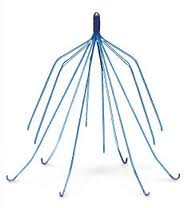Thousands of people have been injured by temporary IVC filters. These products are not designed to be permanent, but less than 50% are ever removed. The longer it remains implanted, the higher the risk of side effects like fracture, migration, organ damage, blood clots, and death.
What You Can Do & How We Can Help
The Schmidt Firm, PLLC is currently evaluating IVC filter cases in all 50 states, regardless of whether you have been injured or not. If you or somebody you know was implanted with an IVC filter, you should contact our lawyers immediately for a free case consultation. Please use the form below to contact our Defective Medical Device Litigation Group or call toll free 24 hours a day at (866) 920-0753.
Frequently Asked Questions
Overview
What is the inferior vena cava?
What is an IVC filter?
What else are IVC filters called?
Why are IVC filters used?
What are some types of IVC filters?
How many IVC filters are implanted every year?
Complications
What is the problem with IVC filters?
What are IVC filter side effects?
How many people have been injured?
Has the FDA issued warnings?
Are there stronger warnings in other countries?
When should a temporary filter be removed?
Why are vena cava perforations so common?
IVC Filter Lawsuits
Can I file a lawsuit against C.R. Bard?
Can I file a lawsuit against Cook Medical?
Have there been IVC filter settlements?
Is there an IVC filter class action?
How much time do I have to file a lawsuit?
How can a lawyer help?
What is the inferior vena cava?
The inferior vena cava (IVC) is the largest vein in the body. It carries de-oxygenated blood from the legs to the heart. It runs along the spine, starting in the pelvis and going up to the heart.
What is an IVC Filter?
An IVC filter is a wire device that is implanted inside the inferior vena cava. They come in many shapes, but the most popular are cone-shaped with up to 12 wire legs radiating from a central point with a retrieval hook. Doctors implant them laparoscopically through the neck or groin.
What else are IVC filters called?
They also called “vena cava filters” or “blood clot filters.”
Why are IVC filters used?
IVC filters prevent pulmonary embolisms (blood clots in the lungs) in patients who can’t take blood-thinning medications. They are often used in patients with:
- Blood clots
- Deep Vein Thrombosis (DVT)
- Trauma victims (gunshot, car accident, etc.)
- Immobile
- Recently had surgery or delivered a baby
- Patients on dialysis
What are some types of IVC filters?
- C.R. Bard Recovery
- C.R. Bard G2
- C.R. Bard G2X, G2 Express
- C.R. Bard Eclipse
- C.R. Bard Meridian
- C.R. Bard Denali
- Cook Medical Günther Tulip
- Cook Medical Celect
- B. Braun TempoFilter
- B. Braun VenaTech
- Rex Medical (Argon) Option
- Volcano Corp. Crux
- Cordis OptEase
- Cordis TrapEase
How many IVC filters are implanted every year?
It is estimated that 250,000 IVC filters are implanted every year in the United States.
What is the problem with IVC filters?
Permanent IVC filters with sturdy designs have been on the market since the 1970s. In the 1990s, manufacturers created temporary IVC filters with flexible designs that could be removed.
Unfortunately, some of these retrievable filters are also more likely to break, tilt, or migrate into the heart. Another problem is that less than 50% of temporary filters are ever removed.
What are IVC filter side effects?
- Fracture: The wire legs can break off and travel in the bloodstream (called “embolization”) until they get stuck in the heart. It may be impossible to remove the broken pieces.
- Migration: The filter can move out of position and cause severe organ damage or fail to protect against blood clots.
- Organ damage: The filter can perforate the vena cava, lacerate the heart or lungs, become clogged with blood clots, cause severe irregular heart rhythm, and more
- Blood clots: The most common long-term complication is a blood clot inside or below the filter, known as “filter thrombosis.”
- And more
How many people have been injured?
Thousands of people have been injured by IVC filters. At least 27 deaths and over 300 injuries have been associated with the C.R. Bard Recovery IVC filter, which was withdrawn from the market in 2005. Another 12 deaths and hundreds of injuries have been linked to the C.R. Bard G2, which was pulled off the market in 2010, according to an investigation in September 2015 by NBC News.
Has the FDA issued warnings?
Yes. In August 2010, the FDA issued a Safety Communication after receiving 921 adverse event reports involving IVC filters since 2005. The agency was especially concerned about temporary filters that were not being removed.
Are there stronger warnings in other countries?
Yes. Health Canada asks all hospitals that implant IVC filters to identify patients and make formal follow-up plans to remove the filter. These recommendations have also been made by the Australian Therapeutic Goods Administration (TGA). Canada also says filters should only be implanted in patients who cannot take blood-thinning medications, and only if they have been diagnosed with blood clots in the legs or lungs.
In the U.S., guidelines are far more relaxed and hospitals routinely implant IVC filters in patients who are at risk of blood clots — even if the patient does not have any blood clots yet, or if they can take a blood-thinning medication instead. This is one reason why thousands of people have been injured by IVC filters in the U.S., but less than two dozen people in Australia.
When should a temporary filter be removed?
In May 2014, the FDA recommended removing temporary filters between 29 and 54 days after implantation, or as soon as the patient’s risk of blood clots subsided.
Why are vena cava perforations so common?
The walls of the vena cava are incredibly thin because it carries blood under very low pressure.
Can I file a lawsuit against C.R. Bard?
Over 1,000 IVC filter lawsuits have been filed against C.R. Bard. They are centralized in a federal Multi-District Litigation (MDL No. 2641) in the U.S. District Court for Arizona under Judge David G. Campbell.
Can I file a lawsuit against Cook Medical?
Over 1,000 IVC filter lawsuits have been filed against Cook Medical. They are centralized in MDL No. 2570 in the U.S. District Court for the Southern District of Indiana under Judge Richard Young.
Have there been IVC filter settlements?
Yes. In February 2015, after a 10-day trial, C.R. Bard paid a confidential settlement to Kevin Phillips, a man who was injured by the Recovery IVC filter. He filed the lawsuit in June 2012 after a piece of the filter broke off and perforated his heart.
Is there an IVC filter class action?
Yes. Class action lawsuits have been filed on behalf of everyone who was implanted with an IVC filter made by C.R. Bard — even people who have not been injured yet. Lawyers want the company to pay for medical screening to check the position and condition of IVC filters.
How much time do I have to file a lawsuit?
The amount of time you have to file a lawsuit depends on the state where you live and laws called the “statute of limitations.” It ranges from one to six years. In most cases, the clock starts ticking when your injury occurs. However, it can be longer in certain circumstances.
How can a lawyer help?
Our lawyers will review your case for free and let you know if you are eligible to file a lawsuit. Lawyers can also help you gather medical records, build a strong case, join the litigation, and help you seek compensation through a jury verdict or settlement.
Do I have an IVC Filter Lawsuit?
The Schmidt Firm, PLLC is evaluating IVC filter cases in all 50 states, regardless of whether you were injured or not. If you or someone you know received an IVC filter implant, please contact our lawyers immediately for a free case consultation. You may be entitled to compensation by filing a lawsuit.
Please use the form below to contact our Defective Medical Device Litigation Group or call toll free 24 hours a day at (866) 920-0753.
Attention Lawyers: We consider a referral from another law firm to be one of the greatest compliments. If your firm is interested in referring us a case or for us to send you a list of previous award judgments and/or average referral fees, please visit the Lawyer Referral section of our website.


 The Schmidt Firm, PLLC has been recognized as one of the nation’s leading plaintiffs' law firms and handles cases in all 50 states. We are very proud of our legal achievements, but equally self-respecting of our firm's reputation for providing personal attention to each and every client we represent.
The Schmidt Firm, PLLC has been recognized as one of the nation’s leading plaintiffs' law firms and handles cases in all 50 states. We are very proud of our legal achievements, but equally self-respecting of our firm's reputation for providing personal attention to each and every client we represent.

